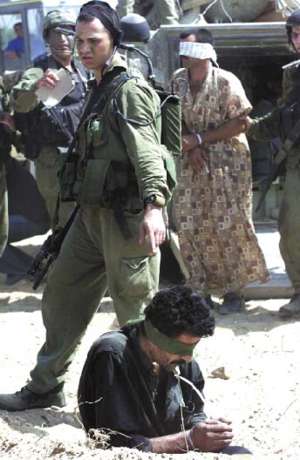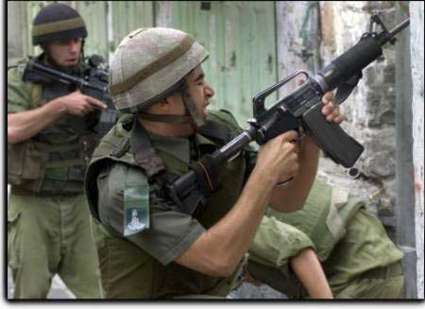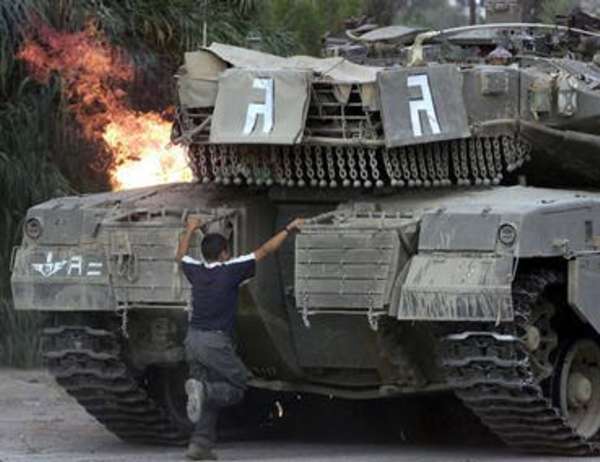
january 2005
PICTURES AT AN EXHIBITION
By Gideon Levy©
If people were shocked recently by photos of soldiers
with the body of a wanted man, they should know that it
was no isolated case, says a soldier whose unit did the
same thing five years ago.
http://www.haaretz.co.il/hasite/pages/ShArtPE.jhtml?itemNo=517346
For five years these photographs lay deep inside a
drawer, in a place no one ever gets to, and Alon Kastiel
didn't open the envelope. Not even once. Back then, after
the army unit's operation, when he and all the rest of
the squad received the photos, he showed them to a friend
or two, but since then he left them undisturbed in the
drawer of a closet in his room. He never showed them to
his parents. Every once in a while, he would remember
that the photographs still existed.
Last week he decided to give them to Haaretz, for
publication in this column. Kastiel says he made the
decision in the wake of the public furor that erupted
after the mass-circulation daily Yedioth Ahronoth
published similar photos a few weeks ago, showing
soldiers standing next to bodies of terrorists. He was
especially incensed by the reaction of MK Aryeh Eldad
(National Union), who said these were exceptional
instances.
"I got uptight when he said that people who are
photographed with bodies are the lowest of the low,"
Kastiel says. "He came out with some kind of
terrible remark like that. He thought he was talking
about 10 soldiers. He said that people who have their
picture taken with bodies have mental problems, that they
are sick. I wanted to show him that his children are in
the same situation."
Alon Kastiel come from a family of leading furniture
makers. He lives in upscale Ramat Hasharon and is a
cousin of "Tuhor," the spiritual teacher of the
basketball player Doron Shefer. Kastiel, 25, is now
studying economics, accountancy and management at Tel
Aviv University. It is three years since he completed his
regular army service, part of which he spent in the
undercover Duvdevan unit. He does reserve duty in a
different unit.
 "I decided to come to
you," he continues, "because I was boiling mad
at the idea that people think these are isolated cases. I
tell myself that we were from the best homes in the
world, the best and most moral people on an everyday
level. In Duvdevan, one is the son of a professor,
another is son of the owner of a large printing press,
and I myself am quite a `northie' [a person from affluent
north Tel Aviv or its suburbs], the finest of the
country's youth, really. If it happened to us, in our
small, high-quality squad, with top-class guys, I have no
doubt that it happens everywhere in the
territories."
"I decided to come to
you," he continues, "because I was boiling mad
at the idea that people think these are isolated cases. I
tell myself that we were from the best homes in the
world, the best and most moral people on an everyday
level. In Duvdevan, one is the son of a professor,
another is son of the owner of a large printing press,
and I myself am quite a `northie' [a person from affluent
north Tel Aviv or its suburbs], the finest of the
country's youth, really. If it happened to us, in our
small, high-quality squad, with top-class guys, I have no
doubt that it happens everywhere in the
territories."
Iyad Batat was a wanted man, a senior member of Hamas who
had shot and killed a Border Policeman, Yehoshua Gavriel,
11 months before being liquidated. Nader Masalma was a
30-year-old junk dealer and the father of five, who lived
on the street where the Duvdevan operation was carried
out. He frequently visited Israel with a permit, in order
to buy and sell alte zachen (second-hand goods). The day
after the operation, his family told us that Masalma had
not even known Batat. A. says that he was Batat's lookout
man; the IDF Spokesman's Office said after the operation
that he had "prepared murderous terrorist attacks,
together with Batat." He was killed on the roof.
"The night the Duvdevan soldiers had dreamed of for
years," was the gung-ho headline of the daily
Maariv. When we arrived at the house in the village of
Beit Awa, near Hebron, the next day, we saw the
destruction that was caused by the massive fire the
soldiers had rained down on the house where Batat had
been. We heard the stories of the horrified tenants,
among them five small children, who had undergone a
traumatic night, first in the besieged and shelled house,
then outside, half naked, in the cold of the middle of
December 1999.
Duvdevan's dream night. The eroticism of the occupation.
This is how it looked, the midwinter night's dream, from
the perspective of Kastiel, who had positioned himself
with his squad beneath the staircase of the neighboring
house, lying in ambush for Batat:
"On the way you get into a state where you feel like
Rambo. You come out of the vehicles on a tremendous high.
You are completely armed from head to foot. You're going
to take Baghdad. All the preparations for the operation
are crackling on the radio, you hear the commanding
officers - great action. The tension builds. Until you
reach the stage of closing in on the house, which is the
peak of the climax. Everyone in his corner is closing in
on the house. Everyone in his position in the village,
which was set in advance.
"We were four fighters in my squad, positioned under
a small staircase in the yard of the house. Terribly
scary. We were all scared. A staircase of seven steps in
a garden, terribly pastoral and quiet. It's 11 P.M. The
village is asleep. At first there is the adrenaline and
you're not afraid, but after, when you get into position,
the fear comes. And the cold - you always feel the cold.
Then suddenly we heard one shot from the house. The radio
starts boiling, everyone is reporting what he saw. We
were dozens of soldiers around the house. All the
communications systems are boiling. Everything goes to
hell after the first shot. Everyone is on the air.
"We quickly got authorization for firing from the
unit commander, after that first shot. We killed  Batat's man on the roof - he was
apparently there as a lookout. There was a bit of an
exchange of fire, which led to a great deal of fire by
us. We emptied out the ammo boxes. There was shooting
there in insane amounts. For a lot of us it was the first
time. You're all worked up. A year after that, in the
depths of the intifada, you're already a lot less
enthusiastic about the shooting. But that night was our
first time.
Batat's man on the roof - he was
apparently there as a lookout. There was a bit of an
exchange of fire, which led to a great deal of fire by
us. We emptied out the ammo boxes. There was shooting
there in insane amounts. For a lot of us it was the first
time. You're all worked up. A year after that, in the
depths of the intifada, you're already a lot less
enthusiastic about the shooting. But that night was our
first time.
"After the insane shooting we do a `freeze,' to
collect a little intelligence. And then there's more
noise from the house and Iyad Batat comes out with a
pistol. The whole force identified him and opened fire.
Everything around was lit up with mortars. After Batat is
killed, we go into a state of freeze again and wait to
see if there are any more terrorists in the house, wait
to let them make the first mistake by making noise. You
want absolute quiet, so it's enough even if a window
blind falls.
"What about the tenants in the building? I don't
remember. This freeze went on for hours. You're lying in
the positions, thinking about the world and really
scared, because you know already that this is no kids'
game. People are shooting here. I remember a small story.
As much as we played the armed he-men, we were dying of
fear. The family whose garden we were in didn't know that
they had four fighters in the garden. One of the boys
suddenly came out and found himself behind us without our
having noticed. That really spooked my commanding
officer. Suddenly we heard a noise behind us and a kid a
little younger than us was standing there and the
commander cocks his weapon and we're all frightened. The
kid turns white and so does our commander. We shouted to
him to get back inside and that was the end of it. In
this state of freeze everyone is uptight because we
already fired. The whole night we try to tell stories and
jokes in a whisper. It was my first shooting experience.
"The last stage comes at first light, in the
morning. Usually a D-9 [bulldozer] comes to demolish the
house. There is a procedure where a dog goes in and then
the final stage, which ends with the D-9. That's how it
goes by the book. This is an operation that was worked on
for many months. Major General Yitzhak Eitan was the head
of Central Command and I remember him briefing us in the
territorial brigade, and he said explicitly, `Today we
get Batat, alive or dead. Today we're finishing the story
with him.'
"I remember it exactly. I remember that I understood
that nothing would happen even if he came out of it dead.
I don't remember if there was D-9 procedure there or
`neighbor procedure' [use of a local resident to enter
the building to flush out possible additional wanted
individuals].You say the house wasn't demolished? Now I
remember that the D-9 was actually in a reverse mode and
the procedure wasn't implemented. We packed up in the
morning. There is a procedure for packing up, called
`Kola.' We were always waiting for Kola."
They went to the brigade base, dozens of wound-up
fighters after a restless night. Then the military
ambulance with the bodies arrived. "The bodies were
unloaded next to the fighters. All the fighters were
seized with enthusiasm. For most of us, I imagine, these
were the first dead bodies we had ever seen. For me, at
least, they were the first, but not the last.
"One of the soldiers started taking pictures with a
small pocket camera. Very quickly there was a big demand
for pictures. Then we took out our gear - there were a
lot of cameras in the unit - and there was a hysterical
demand to have our pictures taken. Everyone wanted
pictures. We were all around the bodies. We spent hours
next to the bodies, waiting for the operation to end
officially and for all the fighters to return. We sat
next to the bodies, we exchanged experiences, we looked,
we played games with the bodies. I think they touched the
bodies a little. The camera made that happen.
"We had a few rounds of pictures taken. It went on
for maybe two hours. You have an hour and a half for
being shocked and then it passes in the photograph. There
was shock at the bodies, they were in an appalling state.
There was a whole lot of ammunition in Batat.
"When we see a camera, everyone runs to stand behind
the bodies, to be in the frame. A souvenir of one of the
most dramatic nights of our lives. I, who was totally
revolted by it, even then, didn't have my picture taken,
but nevertheless a film made its way to me as the
souvenir of a turbulent night. I am standing 20
centimeters from the frame. I am there. I didn't say a
word, I didn't think about morality, it's bodies and not
life, and your commander is having his picture taken with
them and you never make a critical comment to a
commander. All my commanding officers are there. It was
in the center of the base and I am certain they all saw
it. Dozens, maybe hundreds of soldiers around and they
all saw the process of the picture-taking. I remember it
bothered me a little, that thing, but there was
tremendous commotion all around. I was part of it.
"Then we went to the unit and we occupied ourselves
with the topic of how we would develop the photos.
Really. It's not pleasant. I absolutely remember that.
There is a procedure where the pictures are developed at
headquarters, but we couldn't give them things like that.
It wouldn't have gone through. It would have got stuck
somewhere and created a snafu. They were private photos.
Anyone who would see the pictures would be shocked. So we
had a mechanism of not sending certain pictures to HQ to
be developed.
"One of the guys volunteered to take the film home.
Then we imagined some woman in a photo shop seeing the
pictures while they were being developed. What would she
think? What would she say? It was a store in Kfar Sava.
About a dozen copies of each photo for all the guys. We
took up a collection and paid.
"You look at the pictures and then you put them in
the most remote corner of the house, making sure you
don't chance on them in the years ahead. They disgusted
me. I don't know what disgusted me more, the bodies or my
behavior. Once a year I saw the bag from a distance and
didn't open it. Burial at the back of the drawer."
Response by the IDF Spokesman: "The incident
referred to took place during an IDF operation aimed at
arresting the senior wanted individual Iyad Batat in Beit
Awa village in December 1999. The pictures were taken at
the end of the operation.
"When the commanders learned of it, the subject was
investigated by the highest officials and disciplinary
action was taken against those involved, including
punishing the commanders and confiscating the films. The
IDF gives great importance to its moral strength, no less
than its military strength. IDF soldiers and their
commanders are instructed to act according to the
principles of its ethical code, which outlines their
morality in action. In cases of deviation from the moral
principles, the IDF acts with the full force of the law
against those involved."
When he heard the reaction of the IDF Spokesman's Office,
he was astonished. He said that no one was punished and
that all the films were still in the possession of the
soldiers.
The photographs: Iyad Batat on the stretcher, his face
covered with a mixture of plaster and blood, his left
hand stretched back, his right hand at his side, as
though resting. His eyes are wide open. The soldiers
around are all smiling, some of them broadly, as when the
photographer commands: "Say cheese!" They
arrange themselves in a photographic pose, like hunters
with their prey. Three of them place a hand on the
stretcher on which the dead man is lying. No one, but no
one, looks at him: they are all looking at the camera.
A second photograph shows them kneeling around the two
bodies. A soldier in a black woolen hat leans forward to
make sure he is in the picture. Their commanding officer
leans back, also to make sure he's in the frame. The dead
men lie on stretchers next to each other, head to foot.
There is a frozen smile on the face of Nader Masalma, who
wears black underpants and an undershirt. His hands seem
to be protecting his stomach. The two dead men are lashed
to the stretchers so they won't fall off. They are almost
the same age, those who did the killing and those they
killed.

Tank insignia - corrupt it, mirror it :

 ..:
..: .......
....... .............:
.............: